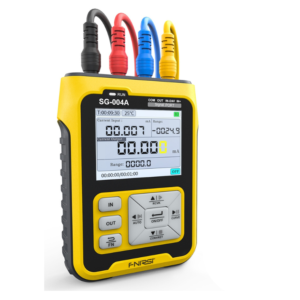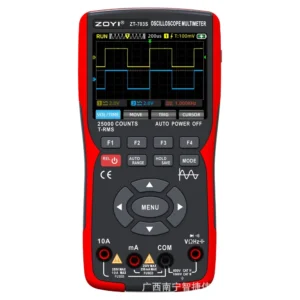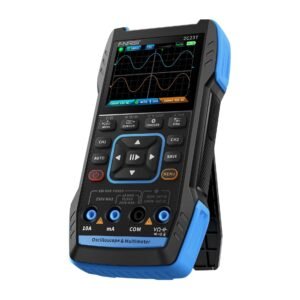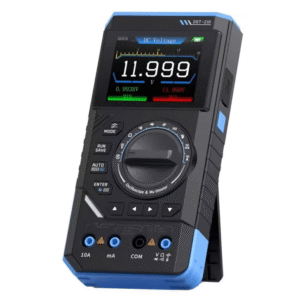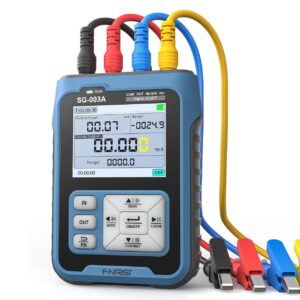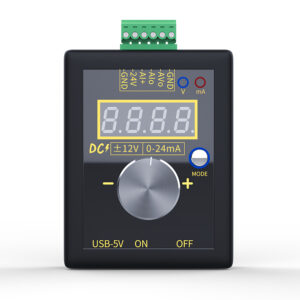Signal Generator
Signal generators are essential tools for electronics, telecommunications, and more, allowing you to create precise waveforms for testing and calibration. Whether you’re designing circuits or testing wireless systems, these devices help simulate real-world signals. At Kunkune, we offer a range of signal generators, including RF, microwave, and function generators, to meet various technical needs. Explore our selection to find the right tools to enhance your projects and ensure accurate results.
Showing all 6 resultsSorted by price: high to low
Showing all 6 resultsSorted by price: high to low
What Is a Signal Generator?
A signal generator is an essential electronic device that produces electrical signals, typically in the form of oscillating waveforms. These signals are generated for various applications, including testing components, designing electronic circuits, and facilitating communication in modern devices such as RF signal generators, microwave signal generators, and arbitrary waveform generators.
Signal generators can create a variety of waveforms, including sine, square, and triangular waves, allowing engineers to simulate real-world scenarios for accurate electronic measurements and waveform synthesis. In essence, a signal generator plays a crucial role in the development of technologies such as mobile communications, audio equipment, and video signal generator applications.
Why Do You Need a Signal Generator?
A signal generator is essential in various fields, from electronics to telecommunications, as it facilitates thorough testing and validation of electronic components and systems.
Engineers and technicians rely on signal generators to create specific electrical signals that are used to test the performance and reliability of devices, such as RF signal generators for mobile communications, microwave signal generators for high-frequency applications, and video signal generators for audiovisual equipment.
What Are the Applications of a Signal Generator?
Signal generators have a wide array of applications across different industries, including telecommunications, electronics, and audio engineering. For instance, RF signal generators are used extensively in the development and testing of wireless communication devices such as GSM, W-CDMA, LTE, Wi-Fi, and WiMAX systems, while audio-frequency signal generators are critical in audio equipment testing to ensure sound quality and output performance.
In the realm of telecommunications, these devices enable engineers to simulate various signal conditions, ensuring robustness against potential interference. In electronics manufacturing, they play a pivotal role in testing components like circuit boards, amplifiers, transceivers, and digital communication systems.
- Test and Measurement: Signal generators assist in characterization and validation processes within laboratories.
- Research and Development: Engineers utilise these systems to prototype and refine new technologies.
- Educational Purposes: They serve as vital tools in academic institutions for teaching students about signal processing.
The versatility of such generators, from generating low-frequency audio waveforms to high-frequency RF signals needed for advanced communication systems, underscores their importance in diverse applications, including analog signal generators and modern devices.
What Types of Signals Can a Signal Generator Produce?
Signal generators can produce a variety of signal types, including sinusoidal, square, triangular, and arbitrary waveforms. The ability to generate these signals across a specific frequency range makes them vital in applications that require precise electronic measurements, such as amplitude modulation for RF communication or waveform synthesis for testing and calibration. Additionally, function generators and digital pattern generators are often used to create these varied waveforms.
Different types of signal generators cater to diverse needs within electronics:
- Sinusoidal Waveforms: Known for their smooth periodic oscillations, these signals are used in audio applications and RF communication, providing a clean output.
- Square Waveforms: Their rapid transitions allow for applications in digital systems, serving as a fundamental signal for clock generation.
- Triangular Waveforms: Often applied in testing environments, these provide linear ramping which is beneficial for audio synthesis and modulation tasks.
- Arbitrary Waveform Generators: These allow users to create tailored signals for precise experimental or product testing.
Each type plays a crucial role, ensuring the effectiveness of modulation functions while accommodating a broad frequency range.
What Are the Key Features of a Signal Generator?
Key features of a signal generator include microprocessor control for enhanced precision, a wide frequency range for signal generation, and various modulation functions that allow for versatile applications. These features make general-purpose signal generators essential for tasks such as creating complex waveforms, including those needed for vector signal generators, pitch generators, and simulating real-world scenarios in electronic measurements.
Along with these core functionalities, modern devices often incorporate user-friendly interfaces, enabling effortless operation even for those who may not be experts in electronics. The integration of digital signal processing allows for high-resolution output and minimal distortion, which is critical for accuracy in testing and development. Integration with devices such as oscilloscopes and computer programs further enhances their functionality.
- Enhanced connectivity options, including USB and LAN, facilitate easy integration with computers and remote systems.
- Built-in analysis tools simplify the process of monitoring and evaluating signals in real-time.
- Advanced modulation types such as frequency and phase modulation provide flexibility in various applications.
Collectively, these advancements ensure that state-of-the-art signal generators remain essential in research, development, and various industrial applications.
How Do You Choose the Right Signal Generator for Your Needs?
Choosing the right signal generator requires careful consideration of several factors, including the specific applications you intend to use it for, the types of signals you need to generate, and your budget constraints.
Various brands and models offer different features, capabilities, and price ranges, making it essential to conduct thorough research to find a signal generator that meets your particular requirements.
What Factors Should You Consider?
When selecting a signal generator, several factors must be considered, including the required frequency range, types of modulation (such as amplitude modulation), and the specific testing components you will be working with. Understanding these aspects will help narrow down your options and ensure that the chosen signal generator aligns with your technical requirements. Additionally, consider whether you need features like waveform synthesis or specific modulation functions.
Along with these fundamental considerations, one must also evaluate the user requirements, which encompass the generator’s portability, ease of use, and interface comprehensibility. Analysing the technical specifications, such as output power levels, stability, and spectral purity, plays a critical role in determining the efficacy of the device for specific applications.
- Application Suitability: Different industries may require unique features, such as the capability to generate complex waveforms for telecommunications tests.
- Integration Potential: Consideration should also be given to how well the signal generator can connect with existing testing setups.
- Budget Constraints: Assess the financial implications, ensuring that the chosen equipment adheres to budgetary guidelines without compromising on essential features.
By taking a comprehensive approach that includes these elements, one can make a more informed decision and select the most suitable signal generator for their specific tasks.
What Are the Different Brands and Models Available?
There are numerous brands and models of signal generators available in the market, including well-known names like General Radio, which offers high-quality RF signal generators, and various Function Generators that cater to different user needs. Each brand has its unique features and specifications, making it crucial to assess your requirements before making a purchase. Additionally, specialised generators like audio oscillators and vector signal generators are available for more focused applications.
Beyond the renowned General Radio, other reputable brands like Keysight Technologies, Rigol, and Tektronix also provide a wide array of options suitable for various applications. These companies specialise in user-friendly interfaces and precise output capabilities, appealing to both amateur hobbyists and seasoned professionals. For instance, RF signal generators, microwave signal generators, and digital pattern generators are among the specialised types offered by these brands.
- Keysight Technologies: Known for their advanced RF and microwave signal generators, perfect for telecommunications.
- Rigol: Offers affordable Function Generators, ideal for educational purposes and basic testing.
- Tektronix: Provides high-performance signal generators with extensive bandwidth options.
By analyzing the available models, users can determine the most appropriate choice tailored to their specific needs, ensuring optimal results in their projects. Assessing factors such as the device’s capability to work with various computer programs can also be beneficial.
What Are the Price Ranges for Signal Generators?
Signal generator prices can vary significantly based on their features and applications. Whether you need a basic function generator or a high-end RF signal generator, understanding your needs and budget constraints is crucial.
Signal generators, including RF signal generators and Microwave Signal Generators, come in a wide range of price points, depending on the model’s features, capabilities, and brand reputation, with basic models starting at a few hundred pounds and advanced systems reaching into the thousands. Understanding the price ranges for different signal generators can help you find one that fits your budget while still meeting your technical requirements.
When exploring signal generators, it is crucial to consider how specific attributes play a pivotal role in influencing the overall cost. For instance, basic models typically offer limited frequency ranges and lower output power, making them suitable for hobbyists or educational purposes. In contrast, advanced models come equipped with enhanced features, such as:
- Wider frequency ranges
- Higher output power levels
- More modulation schemes such as AM, FM, and PWM
- Improved signal purity
These features dramatically increase functionality, allowing professionals to conduct more complex experiments or projects, particularly in digital communication systems like GSM, W-CDMA, LTE, Wi-Fi, and WiMAX. Brand reputation can also impact pricing; established brands such as General Radio may carry a premium due to reliability and customer support. Therefore, assessing one’s specific needs and aligning them with the available options is essential for finding a budget-friendly signal generator without compromising quality.
What Are the Safety Precautions When Using a Signal Generator?
When using a signal generator, it is crucial to follow safety precautions to ensure both user safety and the accuracy of electronic measurements. Users should be aware of the potential hazards associated with high-frequency signals and ensure proper earthing and shielding to avoid interference.
Along with these fundamental practices, it is also essential to conduct regular maintenance to identify any worn-out components that could compromise safety and functionality. Proper care can prolong the lifespan of the equipment and enhance measurement precision. Consider the following points:
- Electrical Safety: Always disconnect power sources when making adjustments and use insulated tools to minimise shock hazards.
- Calibration: Regularly calibrate the signal generator to maintain accuracy, as even slight deviations can lead to significant discrepancies in results.
- Environment: Operate the generator in a controlled environment to protect against humidity and temperature fluctuations.
By adhering to these guidelines, users can not only safeguard themselves but also achieve reliable conductive measurements effectively.
How Do You Use a Signal Generator?
Using a signal generator, such as a Function Generator or Vector Signal Generator, effectively requires familiarity with its controls and settings, which can vary widely among different models. By understanding how to connect the signal generator to your device and accurately set the desired frequency and amplitude, you can start generating signals that are crucial for testing and design applications.
Step 1: Familiarise Yourself with the Controls and Settings
Before using a signal generator, it is important to familiarize yourself with its controls and settings, which typically include frequency selection, amplitude adjustment, and modulation function options. Understanding these controls will enable you to tailor the generated signals to your specific testing needs.
When operating a signal generator, the frequency selection is crucial as it determines the signal’s oscillation rate, which can impact signal integrity during experiments. Users can often set frequencies across a wide range, facilitating the testing of different components.
The amplitude adjustment directly affects the strength of the signal. A higher amplitude can lead to greater signal penetration, making it vital for applications requiring robust signal presence.
- Modulation options: These allow the user to encode information onto the signal, making it essential for communication system testing.
- Output impedance settings: Matching the generator to the device under test ensures maximum power transfer and minimal signal distortion.
By mastering these settings, one can significantly enhance the accuracy and efficiency of signal testing, tailoring outputs for optimal performance.
Step 2: Connect the Signal Generator to Your Device
Connecting the signal generator to your device is a crucial step that ensures accurate signal delivery for testing components, such as those found in audio equipment and video signal generators. This process usually involves using appropriate cables and connectors to link the signal generator’s output to the input of the device being tested.
To achieve optimal performance, it is essential to select high-quality cables and connectors, as these components can significantly affect the integrity of the signal.
Choosing the right type of cable, such as co-axial or twisted-pair, will help minimise signal loss and interference. Double-checking the connection points before conducting tests can prevent potential signal distortions.
Here are some guiding points to consider when connecting:
- Verify compatibility of connectors between the signal generator and the device.
- Inspect cables for any signs of wear or damage that could compromise the signal.
- Use proper adapters if needed to ensure a secure fit.
By taking these precautions, one can ensure reliable and precise testing results.
Step 3: Set the Desired Frequency and Amplitude
Once connected, the next step is to set the desired frequency and amplitude on the signal generator, tailored to your specific testing requirements. This customisation is vital for accurate waveform synthesis and ensures that the generated signals meet the necessary parameters for your application.
Understanding how to adjust these settings is crucial because both frequency and amplitude directly influence the signal characteristics. Frequency determines how quickly the signal oscillates, affecting the overall behaviour of the circuit being tested, while amplitude dictates the strength of the signal, impacting its ability to drive components effectively. Tools like an Oscilloscope can be used to monitor these parameters precisely.
- A higher frequency may lead to increased phenomena like parasitic capacitance affecting the response time.
- Meanwhile, an inappropriate amplitude can lead to distortion or even damage in sensitive equipment.
Therefore, careful attention to these parameters ensures optimal performance and reliability during testing.
Step 4: Start Generating Signals
After setting the frequency and amplitude, you can proceed to start generating signals, utilising the signal generator to produce the desired waveforms for your electronic measurements. This step is crucial for validating the performance and functionality of your devices in real-world scenarios.
To effectively begin the signal generation process, it is essential to take into consideration several factors that may affect the quality and accuracy of the signals.
- First, ensure that the output impedance of the signal generator is appropriately matched to the input impedance of the device under test. This helps in minimising signal reflection and maximising power transfer.
- Next, consider the duty cycle if you are generating square waves, as this can influence the average voltage levels and the behaviour of the circuit.
- Adjusting the phase can be critical, especially in applications involving multiple signals; maintaining phase coherence is often necessary for accurate measurements.
Once these settings are appropriately configured, users can commence signal generation with confidence, allowing for a thorough analysis of performance parameters and electronic behaviour. Remember, attention to detail in this phase pays dividends in the validation of any electronic design, reinforcing its effectiveness in practical applications.
What Are the Maintenance and Care Tips for a Signal Generator?
Proper maintenance and care are essential for ensuring the longevity and optimal performance of your signal generator over time. Regular checks and calibration are crucial in this context, as they help maintain the integrity of the device’s functions and accuracy.
By integrating a routine maintenance schedule, which may involve the use of computer programs for diagnostics, users can address potential issues before they escalate.
- First, make it a habit to inspect all connections periodically. Loose or corroded cables can lead to intermittent signals.
- Next, calibration should be carried out according to the manufacturer’s guidelines, which often entails using specific calibration tools and verifying settings against known standards.
- Keep the signal generator clean, particularly the control panels and vents, to prevent dust accumulation that can affect performance.
Ultimately, adopting these maintenance practices not only prolongs the lifespan of the equipment but also optimises its output, ensuring that users achieve precise and reliable signal generation.
Frequently Asked Questions
How does a signal generator work?
A signal generator, including types such as RF Signal Generators and Microwave Signal Generators, is an electronic device that creates electronic signals, typically in the form of a sine wave, square wave, or triangle wave. It works by generating an electrical signal at a specific frequency and amplitude, which can be adjusted by the user.
A signal generator is an electronic device that creates electronic signals, typically in the form of a sine wave, square wave, or triangle wave. It works by generating an electrical signal at a specific frequency and amplitude, which can be adjusted by the user.
What are the different types of signal generators?
There are several types of signal generators, including Function Generators, arbitrary waveform generators, pulse generators, RF Signal Generators, and Vector Signal Generators. Each type has its own unique features and applications, especially in Digital Communication Systems like GSM, W-CDMA, LTE, Wi-Fi, and WiMAX.
What can a signal generator be used for?
A signal generator has a wide range of uses, including testing and calibrating electronic equipment, troubleshooting circuits with an Oscilloscope, and simulating real-world signals for research and development purposes. It is also commonly used in lab and educational settings for teaching and learning about electronic signals and Audio Equipment.
What features should I look for in a signal generator?
When choosing a signal generator, it’s important to consider factors such as frequency range, accuracy, waveform types, modulation capabilities, and output power. These features will determine the suitability of the signal generator for your specific needs and applications, such as design and testing in Audio Oscillator or Video Signal Generator contexts.
Can a signal generator be used as a standalone device?
Yes, many signal generators, including Analog Signal Generators and Digital Pattern Generators, can be used as standalone devices, meaning they do not require any external equipment to function. However, some signal generators may require external power sources, such as batteries or an AC adapter, to operate.
Are there any safety precautions to keep in mind when using a signal generator?
Yes, it is important to follow all safety guidelines and instructions provided by the manufacturer when using a signal generator. This may include using appropriate protective gear, ensuring proper grounding, and avoiding exposure to high voltages or currents. For instance, when using equipment like those from General Radio, proper safety practices are essential.

